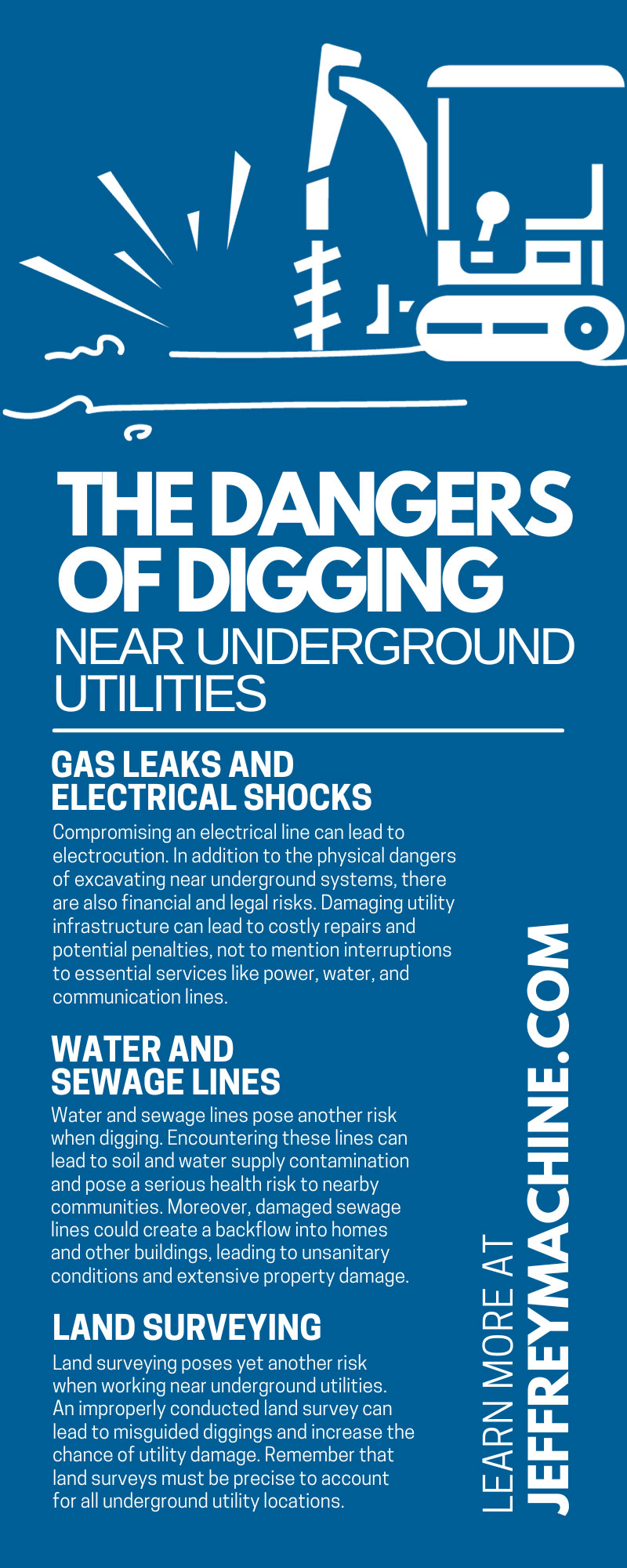The Dangers of Digging Near Underground Utilities

As cities expand, so does the need for underground utilities. These hidden systems of pipelines and cables power homes and offices, transport water, and keep us connected to the Internet. However, digging near underground utilities can be dangerous. If you don't follow your city’s guidelines or are careless with excavations, disastrous consequences can occur.
The dangers of digging near underground utilities include broken gas lines and electric shock, among other problems. As you learn about these hazards, take each point as a lesson to stay safe while working near utilities.
Gas Leaks and Electrical Shocks
One of the most significant risks of digging near underground utilities is causing a gas leak. Striking a gas pipeline can release natural gas into the air, creating a severe explosion hazard or causing asphyxiation to workers in confined spaces.
Compromising an electrical line can lead to electrocution. In addition to the physical dangers of excavating near underground systems, there are also financial and legal risks. Damaging utility infrastructure can lead to costly repairs and potential penalties, not to mention interruptions to essential services like power, water, and communication lines.
Damaging underground utilities could also result in community-wide inconveniences or crises, especially if the area of effect includes emergency services or healthcare facilities.
Water and Sewage Lines
Water and sewage lines pose another risk when digging. Encountering these lines can lead to soil and water supply contamination and pose a serious health risk to nearby communities. Moreover, damaged sewage lines could create a backflow into homes and other buildings, leading to unsanitary conditions and extensive property damage.
The cleanup and rectification process is quite expensive and disruptive. Additionally, these incidents could result in environmental contamination fines and regulatory scrutiny.
Land Surveying
Land surveying poses yet another risk when working near underground utilities. An improperly conducted land survey can lead to misguided diggings and increase the chance of utility damage. Remember that land surveys must be precise to account for all underground utility locations.
Why Is Land Surveying So Important?
Land surveying is crucial for managing underground utilities. It helps you map out utilities in order to avoid unexpected encounters during digging and construction. A mapped utility layout will help your crew work without damaging underground utilities. Additionally, it helps your project managers plan routes around utilities to minimize disruptions. Finally, site managers who comply with land surveying protocols ensure site safety.
Legislation and Regulations
Legislation and regulations play a role in managing and protecting underground utilities. For example, the "Call Before You Dig" or "811" rules in the United States require anyone planning excavation work to call the national 811 number. This process initiates communications with utility companies to inform them of planned work and mark the exact areas of underground facilities in the area. This entire process can prevent project delays or misconduct.
Violations of these regulations can lead to fines that demonstrate the seriousness of the issue. You may also have to obey local regulations regarding digging near underground utilities. Understanding and following these laws promotes worker safety and reduces the risk of legal ramifications. Understanding these laws is paramount for your entire crew.
Encountering Buried Hazardous Waste
Another potential risk when working near underground utilities is encountering buried hazardous waste. Over the years, improper waste disposal methods may have led to dangerous materials being buried, often near utility lines. If disturbed, these substances could threaten human health and that of the environment.
Direct exposure to hazardous waste can lead to health complications. If it contaminates nearby water sources, the surrounding ecosystem will suffer. It’s best to train your workers on recognizing and managing encounters with hazardous waste during excavation or digging activities.
Types of Waste To Inspect and Remove
Identifying and removing hazardous waste are crucial steps that improve the safety of workers and the surrounding environment. Otherwise, toxic waste poses significant problems like contaminated water, soil, and air. By being vigilant about identifying waste, workers can protect the entire community and themselves from negative impacts.
Municipal Solid Waste
Commonly referred to as trash or garbage, municipal solid waste encompasses product packaging, organic waste, and household waste. The diverse nature of these discarded objects emphasizes the importance of safe waste management.
Bio-Medical Waste
Bio-medical waste can carry infectious or biohazardous risks, so certified waste management teams should handle and dispose of this waste.
Electronic Waste (E-Waste)
Old and discarded electronic devices like computers, televisions, cell phones, and rechargeable batteries fall into this category. Without safe disposal, the toxic materials in these items could leach out and severely harm the surrounding ecosystem. Handling and recycling these items responsibly is important to minimize their impact on the environment.
Provide your workers with training on the safe handling and disposal of these types of waste, should they encounter them in the work zone.
Unexpected Geological Conditions
Unanticipated geological conditions can cause problems while digging near underground utilities. For instance, meeting unstable soil conditions during excavations could cause trenches to collapse or the earth to shift. When geological conditions unexpectedly change, they could damage underground utilities and harm workers.
Site planners should study the geological area and evaluate the soil for risks that could interfere with excavation.
Environmental Factors
Environmental factors pose substantial risks when working near underground utilities. For example, extreme weather conditions, such as heavy rainfall or drought, can alter soil conditions and lead to the displacement of underground utilities. When the environment changes during an excavation project, it could expose the utility lines or make them more susceptible to damage. Similarly, natural disasters like earthquakes could disrupt and damage utility infrastructure. You should consider environmental conditions when planning and executing digging projects.
The Importance of Recognizing These Dangers
The dangers of working near underground utilities are serious. Firstly, they threaten the safety of workers performing excavation and construction tasks. A single misstep could lead to serious injuries or health complications due to exposure to hazardous substances. Secondly, these dangers may bring substantial financial burdens upon your company due to repair costs, fines, and potential lawsuits.
Also, disturbing underground utilities can have a negative environmental impact. The impact could stem from releasing hazardous substances or contaminating surrounding soil and water, which can lead to long-term damage to local ecosystems.
Your entire team performing an excavation or construction must be aware of these risks and take all necessary precautions to prevent accidents.
Dig Safely With Jeffrey Machine
As you can see, the safety and success of any digging or excavation project hinge on many things. Selecting the right foundation drilling tools is another factor to success. Jeffrey Machine is a trusted name in the drilling and construction industry. We are known for quality and innovation thanks to our range of drilling attachments.
We encourage everyone involved in excavation projects to explore the remarkable offerings of Jeffrey Machine and experience the difference our tools can make in keeping workers safe and operations smooth. Whether you're planning a small project or a large excavation, remember to choose Jeffrey Machine as your drilling tool supplier.

